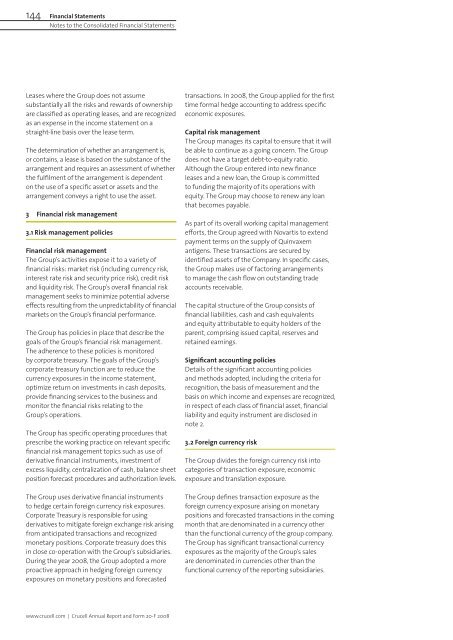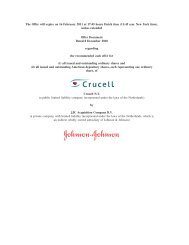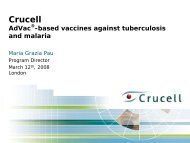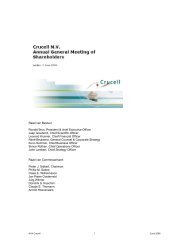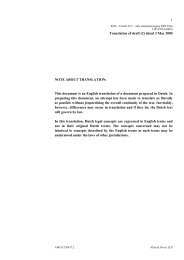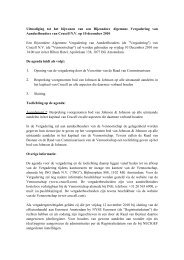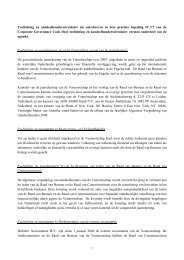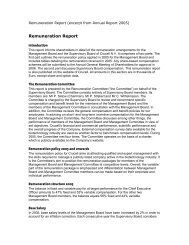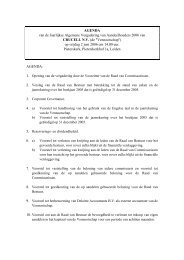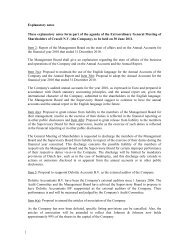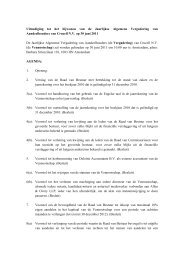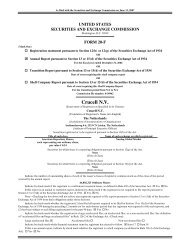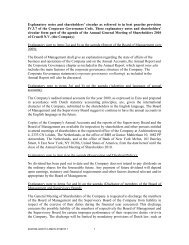Crucell 2008 Combating Infectious Diseases
Crucell 2008 Combating Infectious Diseases
Crucell 2008 Combating Infectious Diseases
Create successful ePaper yourself
Turn your PDF publications into a flip-book with our unique Google optimized e-Paper software.
144 Financial Statements<br />
Notes to the Consolidated Financial Statements<br />
Financial Statements 145<br />
Notes to the Consolidated Financial Statements<br />
Leases where the Group does not assume<br />
substantially all the risks and rewards of ownership<br />
are classified as operating leases, and are recognized<br />
as an expense in the income statement on a<br />
straight-line basis over the lease term.<br />
The determination of whether an arrangement is,<br />
or contains, a lease is based on the substance of the<br />
arrangement and requires an assessment of whether<br />
the fulfilment of the arrangement is dependent<br />
on the use of a specific asset or assets and the<br />
arrangement conveys a right to use the asset.<br />
3 Financial risk management<br />
3.1 Risk management policies<br />
Financial risk management<br />
The Group’s activities expose it to a variety of<br />
financial risks: market risk (including currency risk,<br />
interest rate risk and security price risk), credit risk<br />
and liquidity risk. The Group’s overall financial risk<br />
management seeks to minimize potential adverse<br />
effects resulting from the unpredictability of financial<br />
markets on the Group’s financial performance.<br />
The Group has policies in place that describe the<br />
goals of the Group’s financial risk management.<br />
The adherence to these policies is monitored<br />
by corporate treasury. The goals of the Group’s<br />
corporate treasury function are to reduce the<br />
currency exposures in the income statement,<br />
optimize return on investments in cash deposits,<br />
provide financing services to the business and<br />
monitor the financial risks relating to the<br />
Group’s operations.<br />
The Group has specific operating procedures that<br />
prescribe the working practice on relevant specific<br />
financial risk management topics such as use of<br />
derivative financial instruments, investment of<br />
excess liquidity, centralization of cash, balance sheet<br />
position forecast procedures and authorization levels.<br />
The Group uses derivative financial instruments<br />
to hedge certain foreign currency risk exposures.<br />
Corporate Treasury is responsible for using<br />
derivatives to mitigate foreign exchange risk arising<br />
from anticipated transactions and recognized<br />
monetary positions. Corporate treasury does this<br />
in close co-operation with the Group’s subsidiaries.<br />
During the year <strong>2008</strong>, the Group adopted a more<br />
proactive approach in hedging foreign currency<br />
exposures on monetary positions and forecasted<br />
transactions. In <strong>2008</strong>, the Group applied for the first<br />
time formal hedge accounting to address specific<br />
economic exposures.<br />
Capital risk management<br />
The Group manages its capital to ensure that it will<br />
be able to continue as a going concern. The Group<br />
does not have a target debt-to-equity ratio.<br />
Although the Group entered into new finance<br />
leases and a new loan, the Group is committed<br />
to funding the majority of its operations with<br />
equity. The Group may choose to renew any loan<br />
that becomes payable.<br />
As part of its overall working capital management<br />
efforts, the Group agreed with Novartis to extend<br />
payment terms on the supply of Quinvaxem<br />
antigens. These transactions are secured by<br />
identified assets of the Company. In specific cases,<br />
the Group makes use of factoring arrangements<br />
to manage the cash flow on outstanding trade<br />
accounts receivable.<br />
The capital structure of the Group consists of<br />
financial liabilities, cash and cash equivalents<br />
and equity attributable to equity holders of the<br />
parent, comprising issued capital, reserves and<br />
retained earnings.<br />
Significant accounting policies<br />
Details of the significant accounting policies<br />
and methods adopted, including the criteria for<br />
recognition, the basis of measurement and the<br />
basis on which income and expenses are recognized,<br />
in respect of each class of financial asset, financial<br />
liability and equity instrument are disclosed in<br />
note 2.<br />
3.2 Foreign currency risk<br />
The Group divides the foreign currency risk into<br />
categories of transaction exposure, economic<br />
exposure and translation exposure.<br />
The Group defines transaction exposure as the<br />
foreign currency exposure arising on monetary<br />
positions and forecasted transactions in the coming<br />
month that are denominated in a currency other<br />
than the functional currency of the group company.<br />
The Group has significant transactional currency<br />
exposures as the majority of the Group’s sales<br />
are denominated in currencies other than the<br />
functional currency of the reporting subsidiaries.<br />
Specifically, movements in the US Dollar/ Euro<br />
exchange rate affect the results of operations<br />
because a significant portion of sales are<br />
denominated in US Dollars. The Group’s operating<br />
procedures require group companies to manage the<br />
foreign exchange risks against their functional<br />
currency. The target is to minimize foreign currency<br />
results on balance sheet items. Corporate treasury<br />
may hedge any remaining foreign exchange risk<br />
exposure on balance sheet positions.<br />
The Group defines economic exposure as the<br />
foreign currency exposure to which the Group<br />
committed itself. This is the exposure associated<br />
with the time delay between entering into a<br />
contract, budget or forecast and the realization<br />
thereof. It is not the Group’s policy to actively<br />
manage these exposures, but rather to hedge<br />
economic exposure on a selective basis by<br />
management’s decision. The Group may apply<br />
formal hedge accounting in mitigating these risks.<br />
The translation exposure is the exposure that arises<br />
on the translation of the financial statements of<br />
subsidiaries with different functional currencies<br />
into Euro. The Group has operations in Switzerland,<br />
Korea, Sweden and the US, which all have a different<br />
functional currency than the Euro. Consequently,<br />
movements in the currencies of these countries<br />
against the Euro will affect the results of operations<br />
because the balance sheet and the income<br />
statement of these subsidiaries are translated into<br />
Euro. The Group does not actively hedge its<br />
translation exposure.<br />
Foreign currency risk sensitivity analysis<br />
The Group is mainly exposed to US Dollar, Swiss<br />
Franc, Korean Won, Swedish Crown and Australian<br />
Dollar. The following table details the Group’s<br />
sensitivity to a 10% strengthening of these<br />
currencies. The sensitivity analysis includes<br />
outstanding foreign currency denominated<br />
monetary items and adjusts their translation as<br />
at December 31, <strong>2008</strong> for a 10% change in foreign<br />
currency rates. A positive amount indicates an<br />
increase in income before income tax and equity.<br />
For a 10% weakening of the foreign currencies<br />
against the Euro, there would be approximately<br />
an equal and opposite effect on the income before<br />
income tax and equity.<br />
The sensitivities disclosed above are representative<br />
for the second half of <strong>2008</strong> as the Group applied in<br />
that period a more proactive approach on hedging<br />
of transaction exposures and also applied formal<br />
hedge accounting.<br />
The revaluation effects of investments in foreign<br />
entities are recognized in equity. As we have<br />
significant operations denominated in other<br />
currencies than the Euro, the movements of<br />
currency exchange rates show a significant effect<br />
on equity. It is the Group’s policy to limit the<br />
currency effects through the income statement.<br />
The Group does not proactively manage the<br />
currency exposure on the Group’s equity.<br />
3.3 Interest rate risk<br />
The Group is exposed to interest rate risks as a<br />
result of changes in the market interest rates<br />
compared to loans with fixed rates. The Group has<br />
several loans with fixed interest rates, which total<br />
€ 39,896 (2007: € 45,795). The Group has financial<br />
liabilities of € 20,855 with a variable interest rate as<br />
at December 31, <strong>2008</strong>. Details on the interest rates<br />
and maturity of these loans are provided in note 5.19.<br />
The Group has cash balances of € 183,865 of which<br />
€ 12,896 is restricted. (2007: € 177,644 of which<br />
€ 14,396 is restricted.) There are no other receivables<br />
that generate interest. The cash balances, including<br />
restricted cash, are either variable or fixed for a<br />
maximum period of 3 months.<br />
<strong>2008</strong> 2007 2006<br />
Impact on Impact on Impact on<br />
income Impact on income Impact on income<br />
statement equity statement equity statement<br />
US Dollar 229 482 1,876 517 321<br />
Swiss Franc (373) 17,980 (4,950) 19,706 (1,180)<br />
Korean Won (133) 8,414 860 8,055 1,113<br />
Swedish Crown (538) 2,924 (486) 3,825 (33)<br />
Australian dollar 5 808 882 — —<br />
www.crucell.com | <strong>Crucell</strong> Annual Report and Form 20-F <strong>2008</strong> www.crucell.com | <strong>Crucell</strong> Annual Report and Form 20-F <strong>2008</strong>


